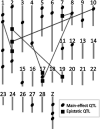Genetic Mapping of Quantitative Trait Loci for Egg Production and Egg Quality Traits in Chickens: a Review
- PMID: 32908402
- PMCID: PMC7477176
- DOI: 10.2141/jpsa.0160121
Genetic Mapping of Quantitative Trait Loci for Egg Production and Egg Quality Traits in Chickens: a Review
Abstract
Chickens display a wide spectrum of phenotypic variations in quantitative traits such as egg-related traits. Quantitative trait locus (QTL) analysis is a statistical method used to understand the relationship between phenotypic (trait measurements) and genotypic data (molecular markers). We have performed QTL analyses for egg-related traits using an original resource population based on the Japanese Large Game (Oh-Shamo) and the White Leghorn breeds of chickens. In this article, we summarize the results of our extensive QTL analyses for 11 and 66 traits for egg production and egg quality, respectively. We reveal that at least 30 QTL regions on 17 different chromosomes affect phenotypic variation in egg-related traits. Each locus had an age-specific effect on traits, and a variety in effects was also apparent, such as additive, dominance, and epistatic-interaction effects. Although genome-wide association study (GWAS) is suitable for gene-level resolution mapping of GWAS loci with additive effects, QTL mapping studies enable us to comprehensively understand genetic control, such as chromosomal regions, genetic contribution to phenotypic variance, mode of inheritance, and age-specificity of both common and rare alleles. QTL analyses also describe the relationship between genotypes and phenotypes in experimental populations. Accumulation of QTL information, including GWAS loci, is also useful for studies of population genomics approached without phenotypic data in order to validate the identified genomic signatures of positive selection. The combination of QTL studies and next-generation sequencing techniques with uncharacterized genetic resources will enhance current understanding of the relationship between genotypes and phenotypes in livestock animals.
Keywords: chickens; egg production trait; egg quality trait; epistasis; genotype-phenotype relationship; quantitative trait loci.
2017, Japan Poultry Science Association.
Figures




Similar articles
-
Mapping quantitative trait loci for egg production traits in an F2 intercross of Oh-Shamo and White Leghorn chickens.Anim Genet. 2011 Dec;42(6):634-41. doi: 10.1111/j.1365-2052.2011.02190.x. Epub 2011 Apr 14. Anim Genet. 2011. PMID: 22035005
-
A longitudinal quantitative trait locus mapping of chicken growth traits.Mol Genet Genomics. 2019 Feb;294(1):243-252. doi: 10.1007/s00438-018-1501-y. Epub 2018 Oct 12. Mol Genet Genomics. 2019. PMID: 30315370
-
Identification of quantitative trait loci associated with egg quality, egg production, and body weight in an F2 resource population of chickens.Anim Genet. 2006 Apr;37(2):106-12. doi: 10.1111/j.1365-2052.2005.01394.x. Anim Genet. 2006. PMID: 16573524
-
Review of quantitative trait loci identified in the chicken.Poult Sci. 2006 Dec;85(12):2079-96. doi: 10.1093/ps/85.12.2079. Poult Sci. 2006. PMID: 17135661 Review.
-
'Particle genetics': treating every cell as unique.Trends Genet. 2014 Feb;30(2):49-56. doi: 10.1016/j.tig.2013.11.002. Epub 2013 Dec 6. Trends Genet. 2014. PMID: 24315431 Free PMC article. Review.
Cited by
-
Metabolomics Approach Reveals the Effects of Breed and Feed on the Composition of Chicken Eggs.Metabolites. 2019 Oct 13;9(10):224. doi: 10.3390/metabo9100224. Metabolites. 2019. PMID: 31614916 Free PMC article.
-
Breed and feed affect amino acid contents of egg yolk and eggshell color in chickens.Poult Sci. 2020 Jan;99(1):172-178. doi: 10.3382/ps/pez557. Epub 2019 Dec 30. Poult Sci. 2020. PMID: 32416798 Free PMC article.
-
Phenotypic Analysis of Growth and Morphological Traits in Miniature Breeds of Japanese Indigenous Chickens.J Poult Sci. 2022 Jan 25;59(1):38-47. doi: 10.2141/jpsa.0200110. J Poult Sci. 2022. PMID: 35125911 Free PMC article.
-
The role of genetics in determining resistance to coccidiosis in goats a review of current research and future directions.Mol Biol Rep. 2023 Jul;50(7):6171-6175. doi: 10.1007/s11033-023-08520-3. Epub 2023 May 25. Mol Biol Rep. 2023. PMID: 37231218 Review.
-
Prediction of the Effect of Methylation in the Promoter Region of ZP2 Gene on Egg Production in Jinghai Yellow Chickens.Vet Sci. 2022 Oct 16;9(10):570. doi: 10.3390/vetsci9100570. Vet Sci. 2022. PMID: 36288183 Free PMC article.
References
-
- Abasht B, Sandford E, Arango J, Settar P, Fulton JE, O'Sullivan NP, Hassen A, Habier D, Fernando RL, Dekkers JCM, Lamont SJ. Extent and consistency of linkage disequilibrium and identification of DNA markers for production and egg quality traits in commercial layer chicken populations. BMC Genomics, 10: S2 2009. - PMC - PubMed
-
- Broman KW, Wu H, Sen S, Churchill GA. R/qtl: QTL mapping in experimental crosses. Bioinformatics, 19: 889-890. 2003. - PubMed
-
- Broman KW, Sen S. A guide to QTL mapping with R/qtl. Springer, New York: 2009.

